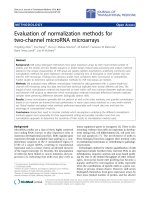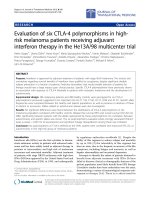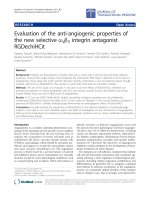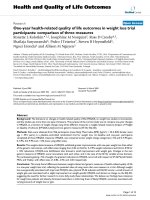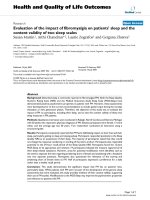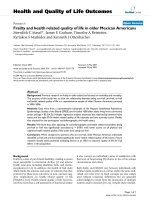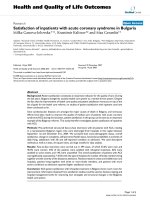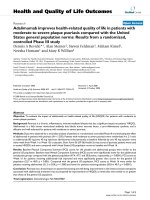báo cáo hóa học:" Evaluation of health related quality of life in irritable bowel syndrome patients" pot
Bạn đang xem bản rút gọn của tài liệu. Xem và tải ngay bản đầy đủ của tài liệu tại đây (218.03 KB, 14 trang )
This Provisional PDF corresponds to the article as it appeared upon acceptance. Fully formatted
PDF and full text (HTML) versions will be made available soon.
Evaluation of health related quality of life in irritable bowel syndrome patients
Health and Quality of Life Outcomes 2012, 10:12 doi:10.1186/1477-7525-10-12
Raika Jamali ()
Arsia Jamali ()
Maryam Poorrahnama ()
Abdollah Omidi ()
Bardia Jamali ()
Neda Moslemi ()
Reza Ansari ()
Shahab Dolatshahi ()
Naser Ebrahimi Daryani ()
ISSN 1477-7525
Article type Research
Submission date 11 November 2011
Acceptance date 29 January 2012
Publication date 29 January 2012
Article URL />This peer-reviewed article was published immediately upon acceptance. It can be downloaded,
printed and distributed freely for any purposes (see copyright notice below).
Articles in HQLO are listed in PubMed and archived at PubMed Central.
For information about publishing your research in HQLO or any BioMed Central journal, go to
/>For information about other BioMed Central publications go to
/>Health and Quality of Life
Outcomes
© 2012 Jamali et al. ; licensee BioMed Central Ltd.
This is an open access article distributed under the terms of the Creative Commons Attribution License ( />which permits unrestricted use, distribution, and reproduction in any medium, provided the original work is properly cited.
1
Evaluation of health related quality of life in irritable bowel syndrome patients
Raika Jamali
1
, Arsia Jamali
2
, Maryam Poorrahnama
2
, Abdollah Omidi
3
, Bardia Jamali
2
,
Neda Moslemi
4
, Reza Ansari
5
, Shahab Dolatshahi
5
, Naser Ebrahimi Daryani
6
.
1
Anatomical Sciences Research Center, Students' Scientific Research Center, Kashan
University of Medical Sciences, Kashan, Iran.
2
Students' Scientific Research Center, Tehran University of Medical Sciences, Tehran,
Iran.
3
Department of Clinical Psychiatry, Kashan University of Medical Sciences, Kashan,
Iran.
4
Laser Research Center of Dentistry, Dental Research Center, Tehran University of
Medical Sciences, Tehran, Iran.
5
Digestive Disease Research Institute, Tehran University of Medical Sciences, Tehran,
Iran.
6
Department of Gastroenterology, Tehran University of Medical Sciences, Tehran,
Iran.
Email addresses:
RJ:
AJ:
MP:
AO:
BJ:
NM:
RA:
NED:
SD:
Corresponding to: Neda Moslemi, Assistant Professor, Laser Research Center in
Dentistry, Dental Research Center, Tehran University of Medical Sciences, Faculty of
Dentistry, North Karegar Avenue, Tehran, Iran.
E-mail: Tel: 98 - 21- 88497429 Fax: 98 - 21- 88492345
2
Abstract
Background: Quality of life (QOL) is an important measure in the management of
Irritable Bowel Syndrome (IBS). Controversy exists in the findings of studies
evaluating QOL in IBS subtypes, and little is known about this issue in Iranian
patients. Determination of the factors affecting QOL in IBS patients may influence
treatment outcomes. The aims of this study are to: 1) compare QOL between
subtypes in a sample of Iranian IBS patients, 2) determine the factors associated with
QOL in IBS.
Methods: This cross sectional study included two hundred and fifty IBS patients with
the mean age (± standard deviation) of 31.62 (± 11.93) years that were referred to
outpatient gastroenterology clinic. IBS patients were diagnosed based on Rome-3
criteria by a gastroenterologist, and then they were categorized into three subtypes
according to the predominant type of bowel habit. The “QOL specific for IBS”, “Stait-
trait anxiety inventory”, and “Beck depression inventory-2” questioners were used to
evaluate QOL, anxiety, and depression symptoms, respectively.
Results: The mean QOL scores in IBS mixed subtype (71.7 ± 25.57), constipation
predominant subtype (80.28 ± 25.57), and diarrhea predominant subtype (76.43 ±
19.13) were not different. (P value: 0.05) In multivariate linear regression analysis,
anxiety symptom scores were inversely correlated with QOL scores. [Standardized
beta: -0.43, (95% confidence interval: -0.70, -0.39), P value: <0.01]
Conclusion: It seems reasonable to manage anxiety symptoms properly in IBS
patients since this might increase their QOL.
Key words: Quality of life; Irritable bowel syndrome; Gender; Anxiety; Depression.
3
Background
Irritable Bowel Syndrome (IBS) is a common gastrointestinal disease [1]. It is
associated with significant direct health-care costs and indirect costs related to
impaired work productivity [2]. IBS patients are diagnosed based on Rome criteria
and are categorized into different subtypes according to the predominant type of
bowel habit [3].
IBS seems to have a great impact on the health related quality of life (QOL) of the
patients [4]. The use of health related QOL assessments have come to interest for
better understanding of the biopsychosocial model in the functional gastrointestinal
disorders [5].
Controversy exists in results of previous studies about QOL in different IBS subtypes
[6-11]. This finding might be related to differences in cultural (such as genetic,
nutritional, and socio-demographical) and psychiatric co-morbidities (such as
depression and generalized anxiety disorder) in the studied populations.
It seems reasonable to determine QOL in different IBS subtypes, and identify the
factors affecting QOL in IBS patients, since these findings may influence treatment
outcomes. While there are substantial data on comparison of QOL in IBS subtypes
and factors independently associated with it in other countries, there is a paucity of
literature on this issue in Iranian patients.
According to the result of previous studies some important variables that seemed to
affect QOL in IBS patients (such as, depression and anxiety symptoms, self reported
symptom severity, educational status, marital status, geographic distribution, age,
gender, and IBS subtype) were selected and evaluated in this study [12-14].
This study was designed to: 1) compare QOL between IBS subtypes in a sample of
Iranian patients, 2) determine the factors independently associated with QOL in
these patients.
Methods
Ethical considerations
This study was performed according to the ethical standards for human
experimentation. The clinical research committee of Kashan Shahid Beheshti
Hospital approved the study protocol (No. 6173). After explaining the aim of the
study, a written informed consent was obtained.
Patients and methods
This cross sectional study was performed on consecutively selected IBS patients,
older than 14 years, who referred to outpatient gastroenterology clinic of Kashan
Shahid Beheshti Hospital between March and November 2010.
Patients with the following criteria were excluded from the study: 1) known organic
gastrointestinal diseases, 2) history of abdominal trauma, surgery, or hospital
admission for evaluation of abdominal pain, 3) exacerbation of bowel symptoms
with consumption of milk or milk products, 4) alarm signs, 5) abnormal laboratory
(hematological and biochemical profiles including thyroid function tests, anti tissue
transglutaminase antibodies, stool exam, and urinalysis) findings, 6) abnormal
findings in barium contrast radiographies, or in upper and lower gastrointestinal
4
endoscopies. Alarm signs consist of new onset of symptoms at fifty years or older,
weight loss, nocturnal diarrhea, anemia, dysphagia, bloody stools, and family history
of cancer [3].
Upper Gastrointestinal endoscopy and colonoscopy with multiple duodenal and
colon biopsies were performed by an expert board certified gastroenterologist for
the evaluation of organic diseases including celiac disease and microscopic colitis.
Gastrointestinal diseases were diagnosed based on the history, physical
examination, laboratory data, imaging, and endoscopic studies that were performed
by the same gastroenterologist. IBS and its subtypes were diagnosed according to
Rome-3 criteria in the absence of alarm signs [3]. Those participants who were
eligible for the study were included.
IBS with constipation (IBS-C) subtype was diagnosed if hard or lumpy stools were
present in more than 25% and loose (mushy) or watery stools in less than 25% of
bowel movements. IBS with diarrhea (IBS-D) subtype was diagnosed if hard or lumpy
stools were present in less than 25% and loose (mushy) or watery stools in more
than 25% of bowel movements. Mixed IBS (IBS-M) subtype was diagnosed if hard or
lumpy stools in more than 25% and loose (mushy) or watery stools were present in
more than 25% of bowel movements [3].
The consistency of stool was defined according to patient report, using Bristol form
scale [15]. Hard or lumpy stools were defined if separate hard lumps like nuts
(difficult to pass) or sausage shaped but lumpy stools were present. Loose (mushy)
or watery stools were defined if fluffy pieces with ragged edges, a mushy stool or
watery, no solid pieces, or liquid stools were present.
Questionnaires
Health related quality of life questionnaire
Disease specific QOL for IBS (IBS-QOL) is a thirty four-item self-report questionnaire.
This questionnaire is especially designed to evaluate QOL in IBS patients [16]. A five
point Likert response scale (0 to 4) was used to measure how much each statement
described the respondents’ feelings (not at all, slightly, moderately, quite a bit, and
extremely or a great deal). The questionnaire evaluated eight subscales: dysphoria,
interference with activities, body image, health worry, food avoidance, social
reaction, sexual function, and relationships [16]. All items scores were summed to
calculate total scores. Higher total scores indicated better QOL.
Depression questionnaire
Presence and severity of the symptoms of depression in participants were
determined using Beck Depression Inventory 2 [17]. This valid and reliable test is a
twenty one-item self-report questionnaire that assesses the existence and severity
of symptoms of depression (for screening and quick diagnosis) as listed in the
American Psychiatric Association's Diagnostic and Statistical Manual of Mental
Disorders Forth Edition (DSM-4) in adults and adolescence over thirteen years. The
patients were asked to consider each statement as it was related to the way they felt
in the past two weeks. Each item score ranges from zero to three. The total score
that ranges from zero to sixty-three predicts the severity of depressive symptoms.
5
The scores ranging from 0 to 13 are indicative of minimal depression, scores from 14
to 19 are considered to reflect a mild level of depression, scores from 20 to 28 are
presenting moderate, and a score ranging from 29 to 63 is labeled severe [18].
Anxiety questionnaire
The presence and severity of symptoms of anxiety in participants were determined
using Spielberger State/Trait Inventory [19]. This self-report questionnaire consists of
20 items for evaluation of state anxiety and 20 items for evaluation of trait anxiety.
The trait anxiety assesses the general tendency for anxiety, while state anxiety is a
measure of anxiety experienced at time of the test. Each item score ranges from one
to four. All items scores in state and trait anxiety were summed to calculate total
scores. The higher total scores indicated higher levels of anxiety symptoms. The
scores ranging from 20 to 31 were indicative of mild state /trait anxiety symptom,
scores from 32 to 53 were considered to reflect a moderate level of anxiety, and
scores higher than 54 were labeled severe [19]. We used the sum of state and trait
anxiety scores as the indicator of anxiety symptom. Therefore, the anxiety score
ranged from 40 to 160 in this study.
The Persian version of the above mentioned questionnaires were shown to be valid
and reliable for use by the previous studies in Iran [20, 21]. The clinical psychiatrist
supervised the participants while they were filling out the self-report questionnaires
to ensure that they answered all questions. The participants could ask the clinical
psychiatrist for clarifications regarding the meaning of the questions and then filled
out the questionnaires themselves.
Self-reported symptom severity questionnaire
The global assessment of symptom severity in the past four weeks was measured
using the question “How bad is the discomfort?” where discomfort was recognized
as abdominal pain and IBS associated bowel symptoms. Responses were graded as
mild (can be overlooked if I do not think about it), moderate (cannot be overlooked,
but does not influence my lifestyle), or severe (influences my lifestyle).
Social characteristics
Educational status was categorized as “low degree” and “high degree” groups. The
low degree group consisted of individuals who had education up to high school. The
high degree group consisted of those who had education more than college. Marital
status was categorized as “married” and “single” groups. The single group consisted
of unmarried, widows, and divorced individuals. Geographic distribution was
categorized into urban and rural. Residents of cities (in the area of study) for the past
years were considered as the urban group. Those living in the countryside were
considered as rural.
Statistical analyses
The Kolmogorov-Smirnov test was used to evaluate the normal distribution of the
continuous variables. Comparison of gender, self-reported symptom severity,
educational status, marital status, and geographic distribution between IBS subtypes
6
were performed using chi-squared test. Comparison of mean age, depression and
anxiety symptoms, and QOL between IBS subtypes was performed by analysis of
variances (ANOVA).
The correlation between QOL and age, gender, self-reported symptom severity, IBS
subtype, educational status, marital status, and geographic distribution, anxiety and
depression symptoms were analyzed using multivariate linear regression analysis
and standardized beta were calculated.
The statistical analyses were performed using SPSS version 17 (SPSS, Chicago, IL,
USA). The probability of the difference between the dependent and independent
variables were considered significant if P value was less than 0.05.
Results
Among the three hundred IBS patients visited in the outpatient gastroenterology
clinic, two hundred and fifty patients (ranging from 14 to 61 years) with the mean (±
Standard Deviation) age of 31.62 (± 11.93) years were eligible for participating in the
study and were enrolled.
The QOL, anxiety and depression symptom scores were normally distributed (Z = 1.3,
1.4, and 1.2 respectively; all P values > 0.05).
The comparisons of mean (± Standard Deviation) age, QOL, anxiety and depression
symptom, gender, self-reported symptom severity, educational status, marital
status, and geographic distribution between IBS subtypes are demonstrated in table
1.
The relationship between QOL scores and age, gender, anxiety and depression
symptom, self-reported symptom severity, educational status, marital status,
geographic distribution, and IBS type in multivariate regression analysis are
demonstrated in table 2.
Discussion
Based on the results of this study, QOL was not different between IBS subtypes. This
finding is in consistence with the results of the previous studies that used different
forms of generic and disease specific questionnaires for the evaluation of QOL [7-9,
11, 22-24]. However, in the study of Erikson et al QOL was lower in IBS-M and IBS-C
when compared with IBS-D [7]. Meanwhile, Si et al reported that QOL in IBS-C is
lower than IBS-D [10].
The anxiety and depression symptom mean scores were not different among IBS
subtypes in this study. This is similar to the results of the previous studies that used
different forms of questionnaires for the evaluation of anxiety and depression
symptoms in IBS patients [8, 9, 23, 25]. On the other hand, Erikson et al showed that
the mean anxiety and depression scores were higher when IBS-C and IBS-M were
compared with IBS-D using “Psychosocial Rating Scale” [7]. Meanwhile, Muscatello
et al showed that the mean anxiety and depression scores were higher in IBS-C than
IBS-D using “Anxiety Status Index” and “Hamilton Rating Scale for Depression” [8].
However, there was no significant difference in the mean anxiety and depression
scores between IBS-C and IBS-D in the same study when “Hamilton Rating Scale for
Anxiety” and “Montgomery-Asberg Depression Rating Scale” was used. Cho et al
7
reported that IBS-C patients had more anxiety and depression symptoms than other
subtypes using “Hospital Anxiety and Depression Scale” [24].
The comparisons of QOL, anxiety and depression symptoms in IBS subtypes increase
our knowledge on the psychometric ability and clinical application of the used
instruments. The differences among the results of above-mentioned studies on QOL,
anxiety and depression symptoms between IBS subtypes may be related to the type
of questionnaire used and cultural differences in the studied populations. When
comparing the results of these cross sectional studies, we should keep in mind that
IBS subtypes may change into one another if they are followed for long enough
periods, therefore comparison of these parameters between IBS subtypes might
change [9].
In this study, QOL was independently associated with anxiety; however, age, gender,
depression symptom, IBS subtypes, symptom severity, geographic distribution,
educational, and marital status were not related to QOL. Jerndal et al proposed that
anxiety was an important factor affecting QOL in IBS patients [26]. Kanasawa et al
found that QOL was not related to gender, IBS subtypes, educational, and marital
status [27]. Simren et al reported that IBS subtypes did not affect QOL [28]. Another
study, which used “World Health Organization QOL-BREF” and “Bradley well-being
QOL” measures, showed that QOL was not affected by socio-demographic
parameters in diabetic patients [29].
Clinical application
As the result of this study showed, QOL was inversely correlated with anxiety
symptom. Therefore, the proper management of anxiety symptom in IBS patients
may improve their QOL.
Strengths and limitations
The strength of this study was comparison of QOL considering anxiety and
depression symptoms in an acceptable sample size of IBS patients. To recognize the
IBS patients accurately, the gastroenterologist and not a general practitioner
examined the participants. The clinical psychiatrist supervised and assisted the
participants to complete the questionnaires precisely and completely.
One limitation of this study is evaluating just the outpatients. This study included IBS
patients who referred to the gastroenterology clinic as an outpatient, and patients
with a history of hospital admission for evaluation of abdominal pain were excluded.
Therefore, the results of this study cannot be generalized to all IBS patients,
especially those with severe symptoms who need hospitalization for further
managements and even those with mild symptoms that do not consult a physician
for their symptoms.
The use of cross sectional design is the second limitation of this study, since the
changes of QOL after proper management could not be evaluated. Considering the
conversion of subtypes into one another in the natural course of disease, this cross
sectional study has a limited value for the evaluation of QOL, anxiety, and depression
symptoms in IBS subtypes [10].
8
Future work
Longitudinal prospective study to assess the changes of QOL after proper
management, and evaluation of factors affecting QOL in Iranian IBS subtypes
including those with severe symptoms (inpatients) and those with mild symptoms
(non-consulters in general population) is recommended.
Conclusions
This cross sectional study conducted on a sample of Iranian IBS patients referred to a
secondary health care center showed that: 1) the mean QOL, anxiety and depression
symptom scores were not different among subtypes. 2) QOL was inversely correlated
with anxiety. Therefore, it seems reasonable to manage anxiety symptom in IBS
patients to increase their QOL.
9
List of abbreviations
IBS: Irritable bowel syndrome, IBS-C: Irritable bowel syndrome constipation
predominant type, IBS-D: Irritable bowel syndrome diarrhea predominant type, IBS-
M: Irritable bowel syndrome mixed type, IBS-QOL: Disease specific quality of life
questionnaire for Irritable bowel syndrome, QOL: Health related quality of life.
Competing interests
This study was supported by research funds of Kashan University of Medical
Sciences.
Authors' contributions
RJ, RA, SD, and ND made contributions to the design of the study. RJ performed the
endoscopy and colonoscopy with mucosal biopsies, diagnosed IBS, and distinguished
subtypes. RJ, AJ, MP, and AO participated in data collection. RJ, BJ, and NM, analyzed
and interpreted the data. All authors read and approved the final manuscript.
Acknowledgement
The authors extend their gratitude to Dr. Vafa Rahimi-movaghar from Sina Trauma
and Surgery Research Center, and Hamed Hosseini from Research Development
Center, Sina Hospital, Tehran University of Medical Sciences, who reviewed the
manuscript. We also thank Professor Manijeh Moshiri from Tehran University and
Mrs. Bita Pourmand from Research Development Center, Sina Hospital, Tehran
University of Medical Sciences, for their special helps and supports.
10
References:
1. Chang FY, Lu CL, Chen TS. The current prevalence of irritable bowel
syndrome in Asia. J Neurogastroenterol Motil;16:389-400
2. Sandler RS, Everhart JE, Donowitz M, Adams E, Cronin K, Goodman C,
Gemmen E, Shah S, Avdic A, Rubin R. The burden of selected digestive
diseases in the United States. Gastroenterology 2002;122:1500-1511
3. Longstreth GF, Thompson WG, Chey WD, Houghton LA, Mearin F, Spiller
RC. Functional bowel disorders. Gastroenterology 2006;130:1480-1491
4. El-Serag HB. Impact of irritable bowel syndrome: prevalence and effect on
health-related quality of life. Rev Gastroenterol Disord 2003;3 Suppl 2:S3-11
5. Yacavone RF, Locke GR, 3rd, Provenzale DT, Eisen GM. Quality of life
measurement in gastroenterology: what is available? Am J Gastroenterol
2001;96:285-297
6. Eriksson EM, Andren KI, Eriksson HT, Kurlberg GK. Irritable bowel
syndrome subtypes differ in body awareness, psychological symptoms and
biochemical stress markers. World J Gastroenterol 2008;14:4889-4896
7. Muscatello MR, Bruno A, Pandolfo G, Micò U, Stilo S, Scaffidi M, Consolo
P, Tortora A, Pallio S, Giacobbe G, Familiari L, Zoccali R. Depression,
anxiety and anger in subtypes of irritable bowel syndrome patients. J Clin
Psychol Med Settings;17:64-70
8. Tillisch K, Labus JS, Naliboff BD, Bolus R, Shetzline M, Mayer EA, Chang
L. Characterization of the alternating bowel habit subtype in patients with
irritable bowel syndrome. Am J Gastroenterol 2005;100:896-904
9. Mearin F, Baró E, Roset M, Badía X, Zárate N, Pérez I. Clinical patterns over
time in irritable bowel syndrome: symptom instability and severity variability.
Am J Gastroenterol 2004;99:113-121
10. Si JM, Wang LJ, Chen SJ, Sun LM, Dai N. Irritable bowel syndrome
consulters in Zhejiang province: the symptoms pattern, predominant bowel
habit subgroups and quality of life. World J Gastroenterol 2004;10:1059-1064
11. Park JM, Choi MG, Kim YS, Choi CH, Choi SC, Hong SJ, Jeong JJ, Lee DH,
Lee JS, Lee KJ, Son HJ, Sung IK. Quality of life of patients with irritable
bowel syndrome in Korea. Qual Life Res 2009;18:435-446
12. Faresjö A, Anastasiou F, Lionis C, Johansson S, Wallander MA, Faresjö T.
Health-related quality of life of irritable bowel syndrome patients in different
cultural settings. Health Qual Life Outcomes 2006;4:21
13. Kovacs Z, Kovacs F. Depressive and anxiety symptoms, dysfunctional
attitudes and social aspects in irritable bowel syndrome and inflammatory
bowel disease. Int J Psychiatry Med 2007;37:245-255
14. Faresjö A, Grodzinsky E, Johansson S, Wallander MA, Timpka T, Akerlind I.
Psychosocial factors at work and in every day life are associated with irritable
bowel syndrome. Eur J Epidemiol 2007;22:473-480
15. Minguez Perez M, Benages Martinez A. The Bristol scale - a useful system to
assess stool form? Rev Esp Enferm Dig 2009;101:305-311
16. Patrick DL, Drossman DA, Frederick IO, DiCesare J, Puder KL. Quality of
life in persons with irritable bowel syndrome: development and validation of a
new measure. Dig Dis Sci 1998;43:400-411
17. Richter P, Werner J, Heerlein A, Kraus A, Sauer H. On the validity of the
Beck Depression Inventory. A review. Psychopathology 1998;31:160-168
11
18. Beck AT, Steer RA, Ball R, Ranieri W. Comparison of Beck Depression
Inventories -IA and -II in psychiatric outpatients. J Pers Assess 1996;67:588-
597
19. Carey MP, Faulstich ME, Carey TC. Assessment of anxiety in adolescents:
concurrent and factorial validities of the Trait Anxiety scale of Spielberger's
State-Trait Anxiety Inventory for Children. Psychol Rep 1994;75:331-338
20. Gholamrezaei A, Zolfaghari B, Farajzadegan Z, Nemati K, Daghaghzadeh H,
Tavakkoli H, Emami MH. Linguistic validation of the Irritable Bowel
Syndrome-Quality of Life Questionnaire for Iranian patients. Acta Med
Iran;49:390-395
21. Ghassemzadeh H, Mojtabai R, Karamghadiri N, Ebrahimkhani N.
Psychometric properties of a Persian-language version of the Beck Depression
Inventory Second edition: BDI-II-PERSIAN. Depress Anxiety 2005;21:185-
192
22. Whitehead WE, Engel BT, Schuster MM. Irritable bowel syndrome:
physiological and psychological differences between diarrhea-predominant
and constipation-predominant patients. Dig Dis Sci 1980;25:404-413
23. Katsinelos P, Lazaraki G, Kountouras J, Paroutoglou G, Oikonomidou I,
Mimidis K, Koutras C, Gelas G, Tziomalos K, Zavos C, Pilpilidis I,
Chatzimavroudis G. Prevalence, bowel habit subtypes and medical care-
seeking behaviour of patients with irritable bowel syndrome in Northern
Greece. Eur J Gastroenterol Hepatol 2009;21:183-189
24. Cho HS, Park JM, Lim CH, Cho YK, Lee IS, Kim SW, Choi MG, Chung IS,
Chung YK. Anxiety, depression and quality of life in patients with irritable
bowel syndrome. Gut Liver;5:29-36
25. Kumano H, Kaiya H, Yoshiuchi K, Yamanaka G, Sasaki T, Kuboki T.
Comorbidity of irritable bowel syndrome, panic disorder, and agoraphobia in a
Japanese representative sample. Am J Gastroenterol 2004;99:370-376
26. Jerndal P, Ringström G, Agerforz P, Karpefors M, Akkermans LM, Bayati A,
Simrén M. Gastrointestinal-specific anxiety: an important factor for severity of
GI symptoms and quality of life in IBS. Neurogastroenterol Motil;22:646-
e179
27. Kanazawa M, Drossman DA, Shinozaki M, Sagami Y, Endo Y, Palsson OS,
Hongo M, Whitehead WE, Fukudo S. Translation and validation of a Japanese
version of the irritable bowel syndrome-quality of life measure (IBS-QOL-J).
Biopsychosoc Med 2007;1:6
28. Simren M, Abrahamsson H, Svedlund J, Bjornsson ES. Quality of life in
patients with irritable bowel syndrome seen in referral centers versus primary
care: the impact of gender and predominant bowel pattern. Scand J
Gastroenterol 2001;36:545-552
29. Kolawole BA, Mosaku SK, Ikem RT. A comparison of two measures of
quality of life of Nigerian clinic patients with type 2 diabetes mellitus. Afr
Health Sci 2009;9:161-166
12
Table 1- Comparison of demographic and psychosocial characteristics between
irritable bowel subtypes
IBS-M
N=120
IBS-C
N=75
IBS-D
N=55
P value
Age (year) 31.97 ± 13.46 32.90 ± 10.09 29.12 ± 10.42 0.18
Gender (number)
Male
60
22
39
0.35
Female 60 36 33
Quality of life 71.70 ± 25.57 80.28 ± 25.57 76.43 ± 19.13 0.05
Anxiety symptom 91.42 ± 21.23 87.92 ± 19.95 92.90 ± 13.80 0.30
Depression symptom 14.49 ± 7.32 11.90 ± 8.39 14.25 ± 6.47 0.05
Symptom severity
Mild 54 46 22 0.07
Moderate 47 22 27
Severe 19 6 6
Educational status
Low degree 99 61 46 0.94
High degree 21 14 9
Marital status
Single 24 9 10 0.34
Married 96 66 45
Geographic distribution
Urban 113 70 50 0.72
Rural 7 5 5
IBS, Irritable Bowel Syndrome; M, Mixed subtype; C, Constipation predominant subtype; D, Diarrhea subtype; N, Number
13
Table 2- The relationship between quality of life and demographic and psychosocial
characteristics in the study population
Standardized beta 95% confidence interval for beta P value
Age 0.08 (-0.43) – (0.07) 0.15
Gender 0.01 (-5.88) – (4.53) 0.79
Anxiety symptom -0.43 (-0.70) – (-0.39) <0.01
Depression symptom -0.06 (-0.69) – (0.29) 0.43
Symptom severity (mild versus others) -0.12 (-13.21) – (0.85) 0.09
IBS subtype (M versus others) -0.10 (-10.27) – (0.20) 0.06
Education status -0.04 (-9.87) – (4.03) 0.41
Marital status -0.00 (-8.17) – (7.66) 0.94
Geographic distribution -0.08 (-18.94) – (1.85) 0.11
IBS, Irritable Bowel Syndrome; M, Mixed subtype

